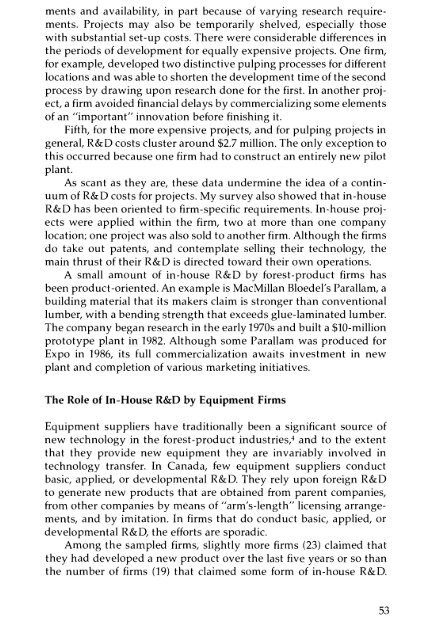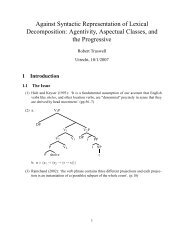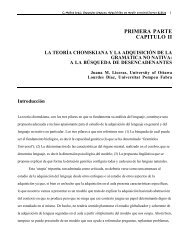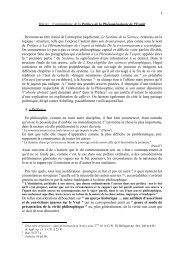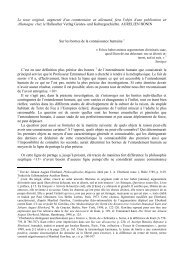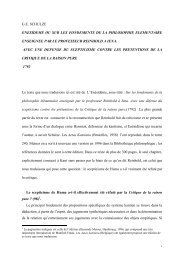Technology and the Canadian Forest-Product Industries ... - ArtSites
Technology and the Canadian Forest-Product Industries ... - ArtSites
Technology and the Canadian Forest-Product Industries ... - ArtSites
You also want an ePaper? Increase the reach of your titles
YUMPU automatically turns print PDFs into web optimized ePapers that Google loves.
ments <strong>and</strong> availability, in part because of varying research requirements.Projects may also be temporarily shelved, especially thosewith substantial set-up costs. There were considerable differences in<strong>the</strong> periods of development for equally expensive projects. One firm,for example, developed two distinctive pulping processes for differentlocations <strong>and</strong> was able to shorten <strong>the</strong> development time of <strong>the</strong> secondprocess by drawing upon research done for <strong>the</strong> first. In ano<strong>the</strong>r project,a firm avoided financial delays by commercializing some elementsof an "important" innovation before finishing it.Fifth, for <strong>the</strong> more expensive projects, <strong>and</strong> for pulping projects ingeneral, R& 0 costs cluster around $2.7 million. The only exception tothis occurred because one firm had to construct an entirely new pilotplant.As scant as <strong>the</strong>y are, <strong>the</strong>se data undermine <strong>the</strong> idea of a continuumof R&D costs for projects. My survey also showed that in-houseR&D has been oriented to firm-specific requirements. In-house projectswere applied within <strong>the</strong> firm, two at more than one companylocation; one project was also sold to ano<strong>the</strong>r firm. Although <strong>the</strong> firmsdo take out patents, <strong>and</strong> contemplate selling <strong>the</strong>ir technology, <strong>the</strong>main thrust of <strong>the</strong>ir R&D is directed toward <strong>the</strong>ir own operations.A small amount of in-house R&D by forest-product firms hasbeen product-oriented. An example is MacMillan Bloedel's Parallam, abuilding material that its makers claim is stronger than conventionallumber, with a bending strength that exceeds glue-laminated lumber.The company began research in <strong>the</strong> early 1970s <strong>and</strong> built a $lO-millionprototype plant in 1982. Although some Parallam was produced forExpo in 1986, its full commercialization awaits investment in newplant <strong>and</strong> completion of various marketing initiatives.The Role of In-House R&D by Equipment FirmsEquipment suppliers have traditionally been a significant source ofnew technology in <strong>the</strong> forest-product industries.' <strong>and</strong> to <strong>the</strong> extentthat <strong>the</strong>y provide new equipment <strong>the</strong>y are invariably involved intechnology transfer. In Canada, few equipment suppliers conductbasic, applied, or developmental R&D. They rely upon foreign R&Dto generate new products that are obtained from parent companies,from o<strong>the</strong>r companies by means of "arm's-length" licensing arrangements,<strong>and</strong> by imitation. In firms that do conduct basic, applied, ordevelopmental R&0, <strong>the</strong> efforts are sporadic.Among <strong>the</strong> sampled firms, slightly more firms (23) claimed that<strong>the</strong>y had developed a new product over <strong>the</strong> last five years or so than<strong>the</strong> number of firms (19) that claimed some form of in-house R&D.53


